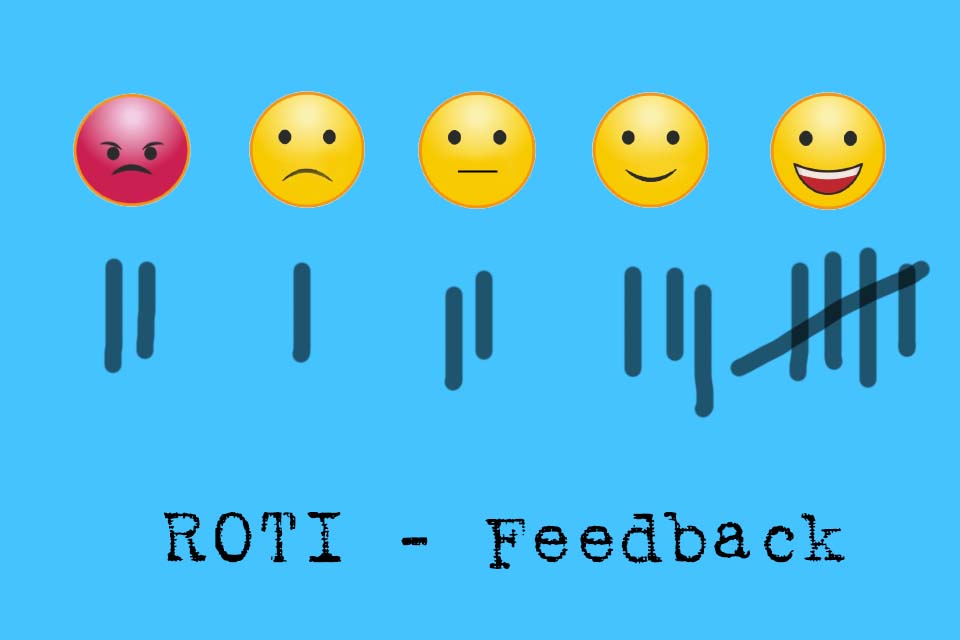What is a ROTI Feedback?
Smartpedia: ROTI stands for Return On Time Invested. It is a feedback method for event participants to assess their benefit in relation to the time invested.
ROTI Feedback – the feedback of benefit in relation to time invested
The evaluation of meetings, workshops, conferences etc. is subjective. ROTI is a feedback method in which participants of an event – e.g. a meeting – are asked for feedback on their participation based on two criteria:
- personal benefit
- in relation to the time invested.
ROTI is all about finding out whether participation in an event was “worthwhile”. ROTI as an acronym stands for Return On Time Invested.
A ROTI Example
An example to illustrate this:
- A meeting lasts 10 minutes. Question X is answered satisfactorily for participant A during the meeting. The participant’s feedback is positive.
- Instead of 10 minutes, the meeting lasts 60 minutes. The participant’s feedback is good to neutral, but certainly less positive than in the 10-minute meeting.
- The meeting lasts two hours. The feedback from participant A is rather negative because the meeting took too much time.
- Question X is not answered at all during the meeting. The feedback from participant A is definitely negative.
This means that the less time is needed to generate benefits for the participants, the better the ROTI feedback will be.
In business practice, a scale with 5 values for ROTI is usually used.
- 1 = worthless, the invested time is lost. Possible quote: “The event was a waste of time for me!”
- 2 = little benefit, too much time was invested for too little benefit. Possible quote: “I invested too much time and learned too little!”
- 3 = balanced ratio, i.e. benefit and invested time are in an appropriate proportion. Possible quote: “The meeting was okay for me!”
- 4 = good, the benefits outweigh the invested time. Possible quote: “The meeting was worth it, it was good that I took part!”
- 5 = valuable. The benefit in relation to the time invested is great. “Excellent and very useful meeting, my time was well invested!
Alternatively there are also scales of
- 0 to 4 (i.e. 0, 1, 2, 3, 4; identical in content to the scale described above, with the zero explicitly characterising the “worthless” meeting)
- -2 to +2 (i.e. -2, -1, 0, +1, +2; the zero stands for the balanced, value-neutral ratio)
- — to ++ (i.e. –, -, 0, +, ++; here too, the zero stands for the value-neutral ratio, otherwise practically the same as the scale before)
- 1 to 10 (much finer compared to a scale with 5 values, although the added value is often limited as the granularity has to be explained in detail and the gain in knowledge often does not justify the additional effort of explanation)
The advantage of a ROTI feedback scale with 5 levels is that the scale is easy to teach and simple to use (e.g. participants could simply communicate their feedback by hand signals; this form of ROTI is also known as the Fist of Five).
The advantages of ROTI feedback
Ease of understanding and use are two advantages that have already been mentioned. The ROTI feedback also offers these advantages:
- ROTI is quick (e.g. simply by a hand gesture, filling in a template or sticking dots on a whiteboard), costs practically no money and hardly any time.
- ROTI is intuitive.
- ROTI makes individual assessments transparent.
- ROTI can be used with virtually any format, e.g. a retrospective, project review, lessons learned session, meeting, conference, workshop, webinar, training, open space, lean coffee, etc.
And not to forget: The implementation of a ROTI feedback ideally delivers a high Return On Invested Time itself, because in the shortest possible time the person asking for feedback receives the desired feedback and the respondents are allowed to give feedback.
ROTI Feedback Experience
Even though the feedback method is simple, there are some experiences that are important in practice:
- Transparency is essential. ROTI feedback could be given “anonymously” e.g. by filling in a template, but it is difficult to deduce from this what could be better next time. A short question and answer session afterwards could therefore be useful or even better: a “public” ROTI.
- What is the consequence of the feedback? For example, does a participant have to justify a “low” rating but not a positive one? So is it easier for participants to give a “pleasant” assessment instead of a “real” one? Here it should be clear what the result of the feedback is. The moderator could, for example, announce that he or she will approach individual participants afterwards to briefly discuss personal assessments.
- How long does the feedback round last? ROTI is a quick format, making participants’ assessments the basis for a longer discussion afterwards is contrary to the format.
- ROTI is a feedback method for obtaining personal assessments. It is therefore useful to ask for personal assessments, e.g. “How was the meeting for you personally?” instead of “How was the meeting for you as a team?”.
ROTI and ROI
It is often said that ROTI and ROI are close to each other. The ROI – Return On Investment – is a business management instrument of investment calculation, in which the capital gain of an investment is assessed. It is often argued that ROTI pursues the same idea, whereby the focus is on the benefit rather than the return on capital. Even if the two terms are linguistically close to each other, in reality they are not. The ROI consideration is ideally carried out before an investment is made, it is primarily a business decision aid and only secondarily serves the subsequent assessment of the investment made. ROTI is not a decision aid, but a simple and quick feedback method.
Impulse to discuss
Does the ROTI feedback unfold its full potential only in combination with the ESVP method?
Notes:
Here you can find an assessment of Return on Time Invested in the software industry.
Here you can find an article about Feedback in action: More than just words.
If you like the article or would like to discuss it, please feel free to share it in your network. And if you have any comments, please do not hesitate to send us a message.
Here you will find additional information from our Smartpedia section:



